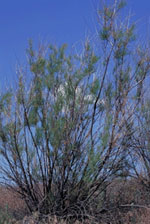Threats to Birds - Tamarisk or Salt Cedar (Tamarix spp.)
Overview
Eight species of Tamarisk, originating in Asia, were planted in the Southwest in the early 1800's as windbreaks, for shade, and to control erosion. Unfortunately, it takes over areas near springs and streams and pushes out native species such as willows and cottonwoods. Tamarisk sucks up so much water that it may leave an area dry. Tamarisk poses a major threat to riparian woodlands which support the greatest levels of biodiversity in fragile desert ecosystems. Human activities, such as dam building and cattle grazing, promote tamarisk. At Bosque del Apache NWR, NM, where tens of thousands of birds winter, tamarisk has taken over 6,000 acres of the 15,000 acre riparian floodplain. Tamarisk threatens large tracts of riparian floodplain throughout the Southwest. It exudes salt from glands in its leaves. Where the leaves fall, salt accumulates in the soil. After several years, the soil is unfit for native plants to grow. As of 1996, 1 million acres in the Southwest were infested with Tamarisk. Tamarisk has desiccated southwestern and Californian desert wetlands. They have become so abundant on islands of the Gulf that much of the native vegetation has been eliminated.
Description
Deciduous shrub or small tree with irregularly spreading-ascending, elongate branches. Leaves are alternate, small, scalelike, a few millimeters long. Flowers are small with 4 or 5 pink or white petals.
Birds Affected
Costa’s Hummingbird; Seaside Sparrow; Abert’s Towhee; Elf Owl; Southwestern Willow Flycatcher; Yellow-billed Cuckoo; Curve-billed Thrasher.
Control
Once Tamarisk is well established it is very difficult and expensive to control. Monitoring, prevention, early detection and local eradication are the most effective ways to control it. Sawing followed immediately with applying herbicide to the stump, is effective. Burning and manipulation of water levels to mimic natural flow regimes can favor native species over Tamarisk. Removing tamarisk must be followed with the development of an ecologically healthy plant community that is weed resistant and meets wildlife objectives. |
